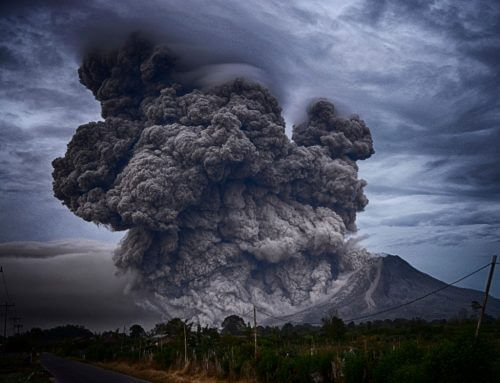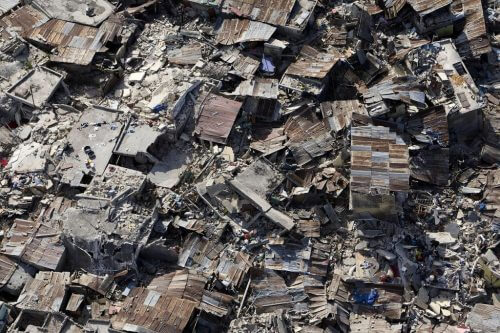Climate change causes strong storms, melting glaciers and rising sea levels - this combination can lead to earthquakes and volcanic eruptions. Sounds like a disaster movie script? According to climate researchers, this is the reality that awaits us in the not-too-distant future
By Dr. Daniel Mader, Zivata - Science and Environment News Agency

Much has been written about climate change and the dangers inherent in it: rising temperatures, melting glaciers, rising sea levels, increasing climatic extremes, droughts, floods, fires, storms, desertification, economic damages, climate refugees, and more. However, until now there was hardly any talk about the connection between climate change and earthquakes, tsunamis and volcanic eruptions.
On the face of it, such a question sounds completely absurd. What about the climate, and the events that originate from the tectonic movement of the Earth's crust and the relationship between the trend in the thickness of the earth and that crust? Is everything in the world really connected to climate change, or maybe the tree huggers are once again trying to scare us with more delusional prophecies of apocalyptic wrath? That's a good question. There is a point in healthy skepticism when you come across articles dealing with the subject, but when you dig a little deeper (literally) into the scientific data, things seem much less illusory.
Climate change causes, as mentioned, an increase in ocean temperatures. In fact, it can be said that climate change is charging the oceans with energy. This energy is released from the oceans in the form of water vapor evaporation and winds created due to temperature differences between the water and the air - this is how storms are created. Many scientists believe that climate change does not cause an increase in the frequency of strong storms and therefore more storms are not expected each season. However, they believe that the intensity of the storms will increase. In fact, we are already encountering this in Israel: if in the past there were more precipitation events that spread over more days and brought down on average less rain per day or hour, then today we are witnessing strong storms that result in tens of millimeters of rain falling (this year even about a hundred millimeters of rain were recorded in one hour ). These storms cause flooding, damage to the power grid, accidents, economic damage and deaths.
Release of pressure in the tectonic plates
"Our" storms are child's play compared to strong tropical storms such as typhoons and hurricanes, which hit other parts of the world. Such storms cause, among other things, a significant drop in barometric pressure (the pressure created by the weight of the atmosphere on the Earth's crust). These changes in barometric pressure are equivalent to removing millions of tons of rock from the surface of the earth. Researchers from Taiwan have found that during the typhoon season in the country there is a much greater probability of the appearance of weak earthquakes compared to the rest of the year. The researchers claim that the low barometric pressure facilitates the release of pressure along the meeting lines of tectonic plates in the form of earthquakes. It is possible that the typhoons are a kind of valves to release this pressure, through a greater number of relatively weak earthquakes - and thus strong earthquakes are avoided in the same area. Evidence that supports this theory is an observation made in the area of Japan, which is on the same meeting boundary between two tectonic plates. Typhoons do not reach this area, but it suffers from much stronger and more destructive earthquakes than the Taiwan area and the Philippines.

We have seen that climate change can cause, on the one hand, an increase in the intensity of typhoons that can neutralize strong earthquakes, and on the other hand, climate change also causes the melting of continental glaciers and thus the removal of millions of tons of ice from continental areas and the rise of the ground, due to the removal of the enormous weight of the ice that pressed the ground down. Such a combination of ground movements and changes in these pressures, when it occurs in geologically sensitive areas, can cause earthquakes and more violent volcanic eruptions. Iceland, known for its volcanoes, geysers and tectonic activity, is located in such a sensitive area. In Iceland, the ground is rising by more than three centimeters a year, due to the melting of the glaciers, at a rate that is increasing every year. As you remember, the great volcanic eruption in Iceland in 2010 caused the paralysis of the aviation in Europe for a considerable period, and considerable economic damages.
Erupt more after the rain
Other studies have shown that typhoons and hurricanes that brought down huge amounts of rain are associated with strong earthquakes. Some researchers believe that the excess water following the storms caused the geological fractures to be cushioned and earthquakes to be released. Others believe that landslides caused by the heavy rains released pressure and weight over geological fractures, or that the weight of water added to the ground causes earthquakes. Examples of strong earthquakes that occurred after heavy rainfall are the strong earthquake in Haiti in 2010, and the earthquake in Nepal in 2015.
The volcano on the island of Montserrat in the Caribbean, erupts more after rains. On the other hand, a volcano near the coast in Alaska reacts to the level of the ocean near it: it tends to erupt when the level of the ocean rises by several tens of centimeters every fall and winter. How does that happen? It seems that the extra weight of water presses on the Earth's crust and causes a lava eruption, like what happens when you squeeze a tube of toothpaste.
Climate change can also affect the frequency of tsunami events. One possibility is through influencing the frequency of earthquakes near coasts. Another possibility is the impact on volcanic eruptions near waterways, which can cause massive landslides. When landslides fall all at once into a lake or sea body, they are capable of causing a tsunami. Also, violent storms with lots of precipitation often cause large landslides due to a significant increase in the weight of the soil, after it has absorbed a lot of water. Melting glaciers, melting snows, and melting frozen ground due to global warming also has the potential to cause landslides that can cause tsunamis. Such events have already taken place in Canada and Chile.
It is easy to imagine what could be caused by the rise in sea level, which is already happening today at a rapid rate and is expected to increase even more due to climate change. It is equally possible to think about the damage that could be caused by more violent storms with more precipitation, as the scientists predict: more earthquakes, more volcanic eruptions, more casualties and damage to the environment.

2 תגובות
Wow, perfect, mother, how crazy
Shouldn't that be the solution? That is, warming which in turn causes volcanic eruptions, which cause the earth to cool?